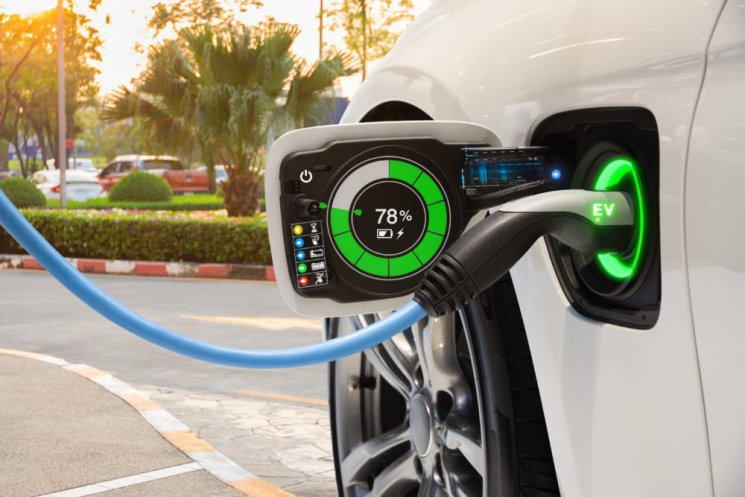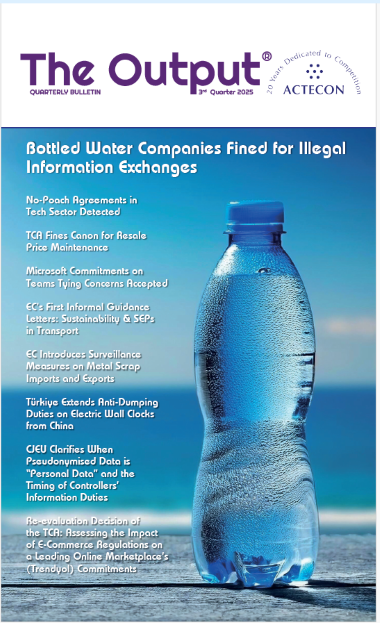Automotive Industry is Moving Towards Electrification via Joint Ventures
| Competition Law

Automotive Industry is Moving Towards Electrification via Joint Ventures
Article by Barış Yüksel, Nabi Can Acar, and Burak Buğrahan Sezer
Triggered by the technological advancements and the demand created by the awareness regarding the protection of the environment, electric vehicles (“EVs”) has become a centre of attention for the automotive industry. Also, the emission regulations contributed significantly to this change and the players that have been active in the manufacturing of traditional fossil fuelled vehicles are increasingly moving towards manufacturing EVs. Such transformation is forcing manufacturers to abandon their long-standing investments into fossil-fuelled cars (both in terms of capital and R&D) and step into an unknown territory. As EV manufacturing requires intensive R&D work and new investments, this environmentalist move of traditional auto makers can be deemed as not (totally) voluntary. Indeed, countries are introducing stricter emission standards and incentive programs for EV adaptation. Moreover, there is a disrupting new player in town, Tesla, an auto maker solely dedicated to EVs.
It is not common for a totally new automaker to successfully execute market entry mainly because the business is highly capital intensive, competitive and requires high levels of safety certification. In this article, we are going to break down what it takes to deliver an EV with references to Tesla’s strategies, mention to some of the important EV related collaborations and make a prediction about future market structure and regulatory expectations.
Tesla’s Market Entry
Tesla was founded in 2003 with the aim of becoming a pure EV brand with a huge footprint. In order to do so, it had to prove the customers that electric vehicles were feasible and realistic alternatives to gasoline cars. To break the prejudice against the EVs, Tesla introduced the Roadster, an EV built around the existing Lotus Elise platform. With the Roadster, Tesla exhibited to the world its battery tech and electric powertrain and then moved to designing a luxury sedan with great performance, the Model S.
Both the Roadster and Model S were aimed at building hype around pure EVs. Indeed, Tesla became a legend among car enthusiasts; the four-door family sedan Model S can outperform every Ferrari in terms of 0-60 acceleration thanks to the electric motor’s instant torque. This approach of Tesla was aimed at gathering demand for a low-priced, high-volume electric vehicle, Model 3 which is projected to bring Tesla among top traditional automakers in terms of production and sales numbers.
To have a sense of why and how a start-up dared to enter into the auto industry, we must understand the fundamental differentiation between EVs and fossil-fuelled cars. Whereas an EV does not require a big and expensive internal combustion engine, it requires a huge battery pack and a well-established charging network.
These inherent differentiations eliminate supply side substitutability between EVs and fossil fuelled cars. In other words, with the electrification process, the already established and well-funded R&D and manufacturing investments of traditional automakers are turning into a sunk cost. Thus, a new entrant into the EV market may actually benefit from a “first-mover advantage” and totally concentrate on building a tailor made EV platform while its competitors are introducing low performing hybrid models, struggling to recover from gasoline investments and refraining from offering zero emission cars.
For instance, while building an EV with efficient battery power and range is an issue, establishing the network for charging is another, possibly more challenging one. It can be argued that there is a significant positive feedback loop in the EV market which stems from the relation between EVs themselves and EV charging stations. Since the charging network plays a key role in consumers’ decisions when determining which EV brand to purchase and the turnover generated by the EVs can then be re-invested in the widening of the EV charging network, considerable network effects are also present. In a more technical language, the characteristics of the EV market leads to a gap between the intrinsic value (the value derived from the inherent properties of EVs) and the synchronization value (the value derived due to EVs having access to a wide network of charging stations) of EVs. Economic theory suggests that the larger this gap, the more significant the advantage gained from being a first mover. This is because, the positive contributions of owning a larger network (e.g. charging stations) on the synchronization value of individual products (e.g. EVs) is non-linear and there is increasing returns of scale.
The current trends in the market support the theoretical explanations. Tesla currently have 1,636 Supercharger Stations with 14,497 Superchargers, solely owned by Tesla and dedicated to Tesla drivers. Being the first entrant and deciding to vertically integrate, Tesla now have the advantage of offering sustainable charging solutions to its customers which traditional auto makers cannot deliver today.
While charging infrastructure is important, delivering EVs is also highly dependent on the battery technology. It is safe to state that the most expensive part of an EV is its battery pack and for a vehicle to be successful, it should have a long range and a reliable battery pack. While the auto industry utilized multiple battery types in different applications, lithium ion battery is the only feasible battery type for EVs. This characteristic of lithium ion battery is also confirmed by the European Commission (“Commission”) in its Case No COMP/M.5421 – PANASONIC/ SANYO decision back in 2009:
“Although NiMH is a proven technology in HEVs, it has certain limitations in terms of weight and energy density when compared to Li-ion which, as acknowledged by respondents to the Commission’s market investigation, appear to make it unsuitable for use in PHEV and EV as the degree of vehicle electrification and the demands placed on the battery increase.
(…)
The market investigation in the present case has demonstrated from both a demand and supply-side perspective that Li-ion batteries for automotive applications, which have yet to be sold in commercially significant quantities, are likely to constitute a distinct product market from NiMH batteries.”
The importance of lithium ion batteries is also recognized by The Royal Swedish Academy of Sciences and the Nobel Prize in Chemistry 2019 is awarded to John B. Goodenough, M. Stanley Whittingham and Akira Yoshino “for the development of lithium-ion batteries”[1].
From an economic perspective, the significance of battery technologies could also lead to first mover advantages for two main reasons. First, user-data could be a significant input for more efficient R&D investments as it could guide the manufacturer in identifying the areas that requires improvements or fixes. As the amount of such data is directly correlated with the number of users, the first mover could have considerable strategic advantages vis-à-vis the newcomers. Second, in case the first mover can secure critical patents in addition to its know-how, this could significantly increase the costs of the newcomers. Moreover, as there is also a positive relation between battery technologies and amount of EVs sold, a superiority in this field could also contribute to the positive feedback loops described above and solidify the strength of the first mover. Hence, the approach of the conventional manufacturers that would enter into the EV market with respect to the battery technologies is also critical for the future of the market.
Lithium Ion Batteries
As the electrification process spreads, the competition between traditional automakers in building powerful and efficient combustion engines is shifting into the battery packs. So, the new battleground for automakers is going to be building higher range vehicles equipped with denser battery packs.
Lithium-ion batteries are also creating kind of a competition between states in terms of production plant locations. Indeed, Europe is working hard to get a piece of lithium ion battery production which is currently dominated by China. To do so, The Commission launched European Battery Alliance[2] back in October 2017 with the aim “to support the scaling up of innovative solutions and manufacturing capacity in Europe”. This tendency can also be followed by latest state aids granted to lithium ion manufacturers LG Chem and Samsung SDI by Poland and Hungary. Poland granted LG Chem an investment aid amounting to €36 million for a new electric vehicle batteries plant in the Dolnoślaskie region which was approved by the Commission on 28.02.2019. Hungary is also planning to grant €108 million of public support to Samsung SDI for investing in the expansion of its battery cell production facility in Göd. The Commission initiated an in-depth investigation with respect to Hungary’s public support to Samsung SDI on 14.10.2019.
EV Joint Venture Era
While traditional automakers had the time and money to vertically integrate and build their own internal combustion engines, the lack of know-how and initial cost of lithium ion battery production forced them to enter into EV related collaborations. This characteristic of the industry was also recognized by the Commission in PANASONIC/ SANYO case by stating that “the sector is characterised by a large number of joint ventures and collaborative developmental projects between car manufacturers, battery suppliers and/or Tier 1 suppliers.” The followings are some of the noteworthy and recent EV related collaborations which also indicates that the industry is indeed and still characterised by joint ventures and collaborative developmental projects:
Toyota/Panasonic[3]
With the Case M.9446 dated 10.09.2019; the Commission has approved establishment of a joint venture between Toyota and Panasonic which will be operating in research and development, manufacture and sale of prismatic automotive batteries, as well as research and development into other automotive battery technologies.
smart: Daimler/Geely[4]
Daimler and Geely notified The Commission of a proposed transaction regarding the establishment of a 50/50 joint venture company on 08.11.2019. The joint venture is planned to be active in the field of manufacture of smart branded pure battery electric vehicles (BEVs) in China, as well as wholesale and retail distribution in China and the EEA. The notification is still pending before the Commission.
LG Chem/Geely[5]
In June 2019 LG Chem and Geely announced establishment of a joint venture company. with a 50/50 shareholding structure to be jointly engaged in the production and sales of new energy vehicle batteries in China.
Toyota/BYD[6]
Toyota and BYD announced on November 2019 establishment of a joint venture company for R&D for EVs. The new R&D company, which will work on designing and developing EVs (including platform) and its related parts, is anticipated to be established in China in 2020, with BYD and Toyota to evenly share 50% of the total capital needed.
Rivian, a Michigan-based electric vehicle start-up announced that it received a $700 million round of funding from Amazon on February 2019. It is later announced in September 2019 that Amazon is ordering 100.000 electric delivery vans from Rivian[9].
Following Amazon’s investment, Ford also announced in April 2019 formation of a strategic partnership through $500 million minority investment in Rivian. The partnership is announced to include manufacturing Ford branded all-new battery electric vehicles using Rivian’s flexible skateboard platform.
Daimler/BMW[10]
The Commission has approved the creation of six different joint ventures by Daimler AG and BMW with its decision dated 07.11.2018 and numbered Case M.8744. The mentioned joint ventures are focused on various the areas including charging services.
As the mentioned collaborations reveal, it is common for automakers to enter into joint ventures with battery manufacturers. With the increase in EV adaptation, once consumer electronics battery suppliers such as Panasonic, LG Chem and Samsung SDI are now facing overwhelming demand of the industry and hold the key to successful EVs. So, it is not surprising to see automakers funding their suppliers as the booming battery demand requires new and expensive manufacturing facilities. However, as will be explained in the next section, we can expect the automakers to make an unexpected manoeuvre in near future.
Towards In-House Battery Production
Collaboration with battery manufacturers may be beneficial in short term as the automakers know little about building batteries. Yet, depending on third parties in terms of the most important and expensive part of a vehicle is obviously undesirable for automakers in long term. It is safe to state that automakers may eventually abolish these collaborations, try to vertically integrate and build lithium ion batteries in-house.
Tesla, the leading EV manufacturer is currently partnering with Panasonic to build its lithium ion battery packs. Elon Musk, the CEO of Tesla publicly complained of Panasonic’s poor performance in lithium ion output and tweeted on April 2019 that “Pana cell lines at Giga are only at ~24GWh/yr & have been a constraint on Model 3 output since July.”. This discomfort is steering Tesla’s future strategy of vertically integrating and is reportedly trying to build its own battery cells to reduce dependence on Panasonic[11]. These reports can also be confirmed from Tesla’s latest battery related acquisitions. On May 2019 Tesla announced its acquisition of Maxwell Technologies[12] a battery company with ultracapacitor technology and unique dry electrode technology for batteries, which is speculated to enable Tesla to develop its own battery cells that are highly durable and with high energy density[13]. Following Maxwell acquisition, it is reported[14] on October 2019 that Tesla acquired Hibar Technologies, a Canada based company specialized in building manufacturing equipment for different processes in battery manufacturing.
What to Expect from a Regulatory Perspective?
The regulatory framework may have crucial impacts on the future of the EV market and especially the pace in which transition to EVs would be realized. Form an environmental perspective there is strong public demand for the governments to support and fasten the transition to EVs (e.g. via tax cuts, subsidies on electricity to be used in EVs etc.). So far pure EV players like Tesla were able to ride that wave. However, when regulatory policies are discussed, divorcing politics from the process could be a fatal mistake. When predictions regarding the future of policies concerning transition to EVs are made, the massive impacts of such policies on various industries that are amongst the strongest interest groups and largest employers on the planet should also be counted in. Although we do not have any intention to provide an exhaustive list of industries that would be affected from this transaction (and thus the policies that would set its pace), the most obvious ones would be the fossil-fuel industry and the conventional automotive industry.
With respect to the fossil fuel industry, a distinction may be made between the producers that are highest up in the chain and distributers that own gas station networks throughout the world. Although the transition to EVs would affect both of these, the effects on producers may be milder as an increase in the use of EVs would be accompanied by an increase in the demand to electricity and as long as electricity is generated through fossil fuels, the producers would not be heavily damaged (hence it may be wiser for them to focus their energies on policies that subsidise renewable energy production rather than those that subsidise EVs). However, a wide-scale transition to EVs could create huge costs on part of distributors as this would inevitably reduce the demand for fuels used in automobiles and also make the current distribution network largely redundant. Therefore, strong lobbying from distributors should be expected against EV-subsidisation policies.
With respect to the conventional automotive industry the relevant interests seem to be more complex.
First of all, due to the feedback loop between EVs and EV charging stations explained above, while the first mover may have the advantage of subsidising its network development costs directly through its revenues generated from the sales of EVs, conventional manufacturers that desire to enter into EV market would have to engage in cross-subsidisations whereby the costs of creating a comparable EV charging network would have to be subsidised from the revenues generated through fossil-fuel vehicle related operations. Yet, considering the fact that EVs compete directly with fossil-fuelled vehicles, the foregoing scenario means that the investments for a disruptive technology (EVs) would have to be compensated by the revenues generated through the older technology that is being disrupted (fossil-fuelled vehicles) and this could create a dilemma. Additionally, transition to EVs would also require significant changes in the established after-sales networks (many of which may simply have to close down) and decrease in the revenues generated through highly lucrative after-sales services. It is highly probable that because of these issues, the manufacturers of conventional vehicles would have a vested interest in ensuring that the transition to EVs would be gradual rather than radical and they may have strong incentives to push for regulations that would slow down the transition process.
Moreover, the conventional automotive industry may also be interested any “pro-competitive” regulations that would grant them access to the established charging network of first movers (e.g. by way of FRAND access requirements) as well as any critical patents they may have, especially regarding batteries.
In light of the foregoing, it may be expected that there would be a clash of interests in the political arena between among others; environmentalists, pure EV players, fossil fuel industry and the conventional automotive industry and the future regulatory framework could be largely shaped by the outcomes of this battle.
Concluding Remarks
Electrification era triggered both by environmentalist regulations and a disrupting new entry is highly exciting. As the superiority of EVs over gasoline vehicles is well demonstrated in last decade, demand for it skyrocketed. Traditional automakers are now forced to change their gasoline tanks and internal combustion engines with lithium ion batteries and small electric motors, they now must compete on delivering vehicles with better batteries.
This fundamental change -in Commission’s own words- is leading up to “a large number of joint ventures and collaborative developmental projects between car manufacturers, battery suppliers and/or Tier 1 suppliers”. It is safe to state that these joint ventures and collaborative developmental projects are aimed at a newly established market and creates high efficiency gains; thus, competition authorities tend to clear the notified transactions in this field. In future however, as automakers gain manufacturing related know-how, may try to reduce dependence on battery manufacturers for the sake of supply security and cost cutting. Thus, we may see automakers acquiring small but battery technology & manufacturing specialized companies instead of establishing joint ventures with battery giants.
Moreover, this issue has complex political aspects and creates tense relations between some very strong interest groups. The moves of these groups as well as their respective effects on future regulations should also be observed closely to better predict what the future may hold for EVs.
[1] https://www.nobelprize.org/prizes/chemistry/2019/press-release/
[2] https://ec.europa.eu/growth/industry/policy/european-battery-alliance_en
[3] https://ec.europa.eu/competition/elojade/isef/case_details.cfm?proc_code=2_M_9446
[4] https://ec.europa.eu/competition/elojade/isef/case_details.cfm?proc_code=2_M_9360
[5] http://global.geely.com/media-center/news/geely-auto-and-lg-chem-to-establish-joint-venture-company-to-produce-batteries-in-china/
[6] https://global.toyota/en/newsroom/corporate/30565932.html
[7] https://media.ford.com/content/fordmedia/fna/us/en/news/2019/04/24/rivian-500-million-investment-ford.html
[8] https://www.cnbc.com/2019/02/15/rivian-announces-700-million-investment-round-led-by-amazon.html
[9] https://www.reuters.com/article/us-amazon-environment-rivian/electric-vehicle-startup-rivian-gets-a-jolt-from-big-amazon-com-van-order-idUSKBN1W42JA
[10] https://ec.europa.eu/competition/elojade/isef/case_details.cfm?proc_code=2_M_8744
[11] https://www.cnbc.com/2019/06/26/tesla-secret-lab-building-battery-cells-to-reduce-panasonic-dependency.html
[12] https://ir.tesla.com/news-releases/news-release-details/tesla-completes-acquisition-maxwell-technologies
[13] https://www.cnbc.com/2019/02/04/tesla-to-but-maxwell-technologies-for-4point75-a-share.html
[14] https://www.cnbc.com/2019/10/07/tesla-reportedly-bought-a-company-for-high-speed-battery-manufacturing.html







